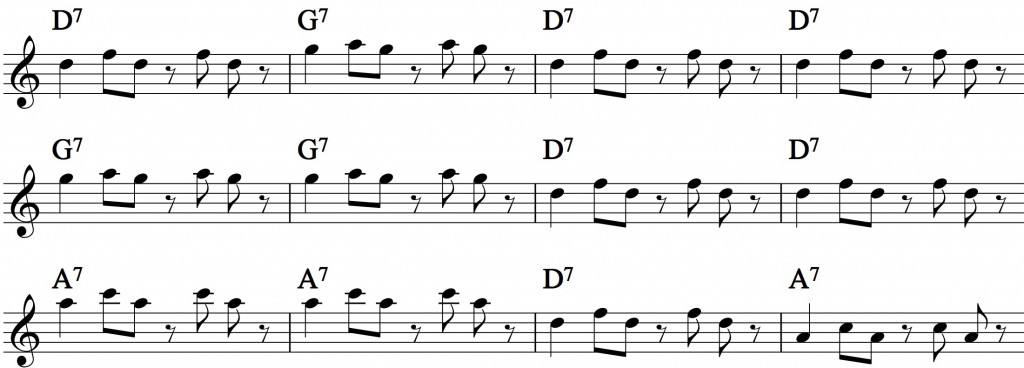This video is intended for the beginning improviser. I talk about the blues form and how you can easily apply a pentatonic scale and still outline the basic chord progression.
This is the second video in the series.

In the pentatonic scale of D minor, the notes D F G A C D, i find all the notes of the roots of the simple blues form.
on the first degree a D, on the fourth degree the G and on the fifth degree the A.

As you see the first bar is a D, second bar is G third and fourth bar is a D, in the fifth and sixth bar you have G, seventh and eights bar is D, ninth and tenth bad is A, the elleventh bar is D and the twelth bar is A.
I divided the pentatonic scale into three groups, one around each root of the basic blues scheme.

The groups consists of the root + one note from the pentatonic above the root and one note below the root.
The D group is root D + F above and C below, G group is root G + A above and F below, A group is root A + C above and G below.
These notes are all diatonic notes to the D pentatonic scale.
I will now slowly start improvising with these groups over the blues. This means that i actually outline the roots of the chords but still stay within very simpel and understandable material.
To learn the groups well you can play the following exercises.

You should try to learn these exercises by heart to be able to play it when you hear it and not when you see this on paper.
You can play these exercises using a metronome to also practise your timing while leaning these groups.
The is the group of G
set the metronome on fx. two and four. 
The group of A
metronome on 2+4 a bit faster.

Start slowly with the metronome in a slow tempo and get the notes into your ears and fingers.

The groups are defined by the roots of the blues.
The D group is root D + F above and C below, G group is root G + A above and F below, A group is root A + C above and G below.
Sourrounding the roots with the closest by diatonic notes of the D minor pentatonic scale.
Ill play a few more examples so you can see how to get on with this concept and use it yourself in youor solos.
The first example:

This example plays a steady rhythm on all bars and applys root of the group and the note below the root. fx. on D group the D and the C. Play through the form many times till you have this very firmly in your ears and fingers.
In the next exercise i change the rhythm and the note choice.

I now play the group root + the note above, fx in the G group i play the G and the Bb.
Try to lear the groups by heart and play as much as you can over the blues with the groups till its firmly planted in your ears and in your fingers.
I wish you very much good luck with this and hope to see you back soon.
Enjoy and have fun playing 🙂
If you want to stay up-to-date with my videos:
subscribe to my newsletter (top left of my website)
and/or
subscribe to my youtube-channel.
You can also find me on twitter, instagram and facebook as sorenballegaard
